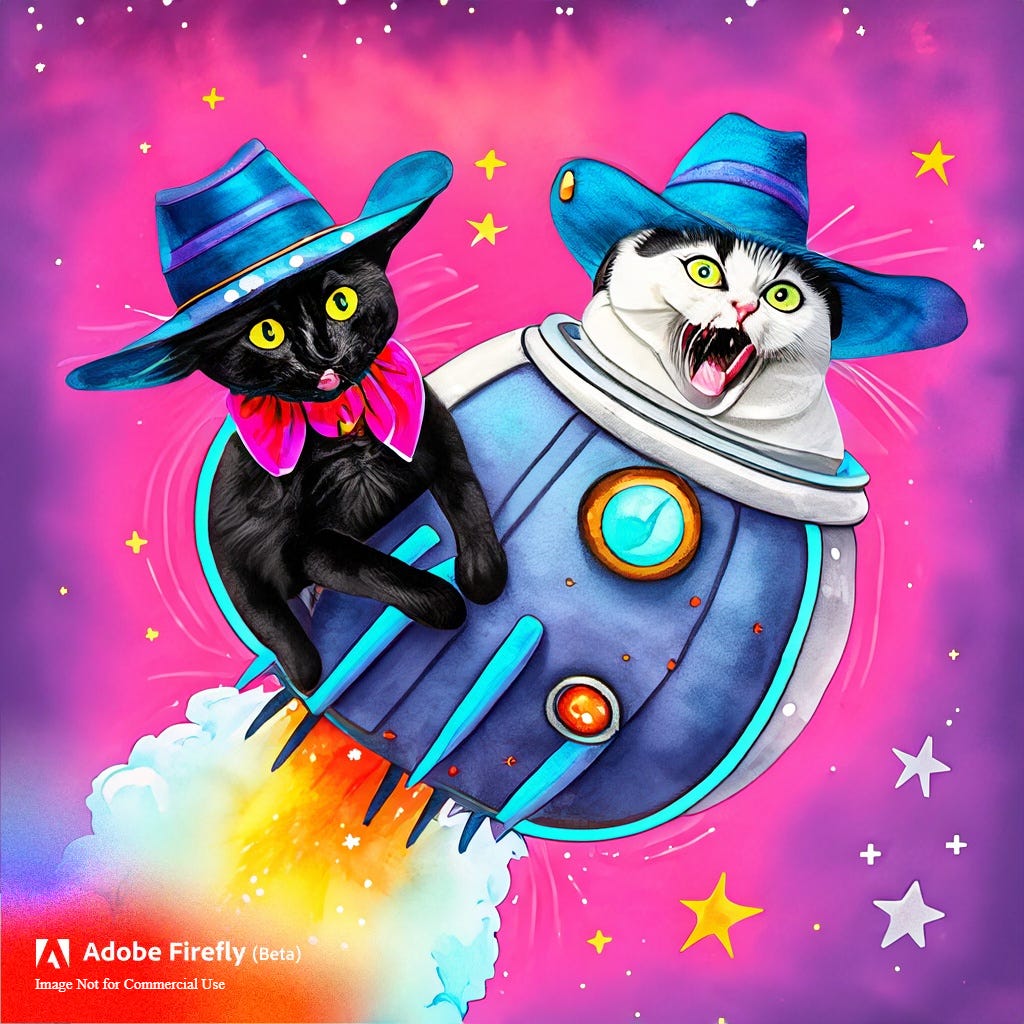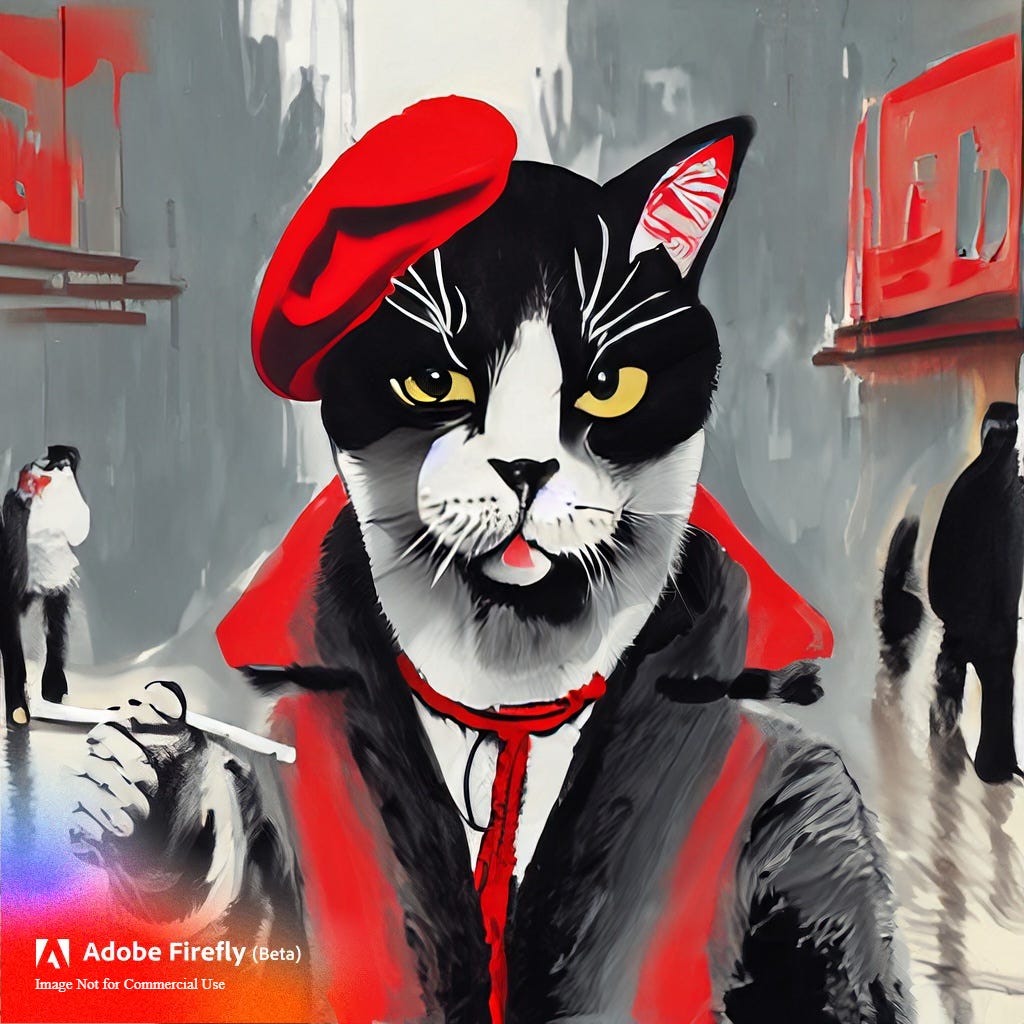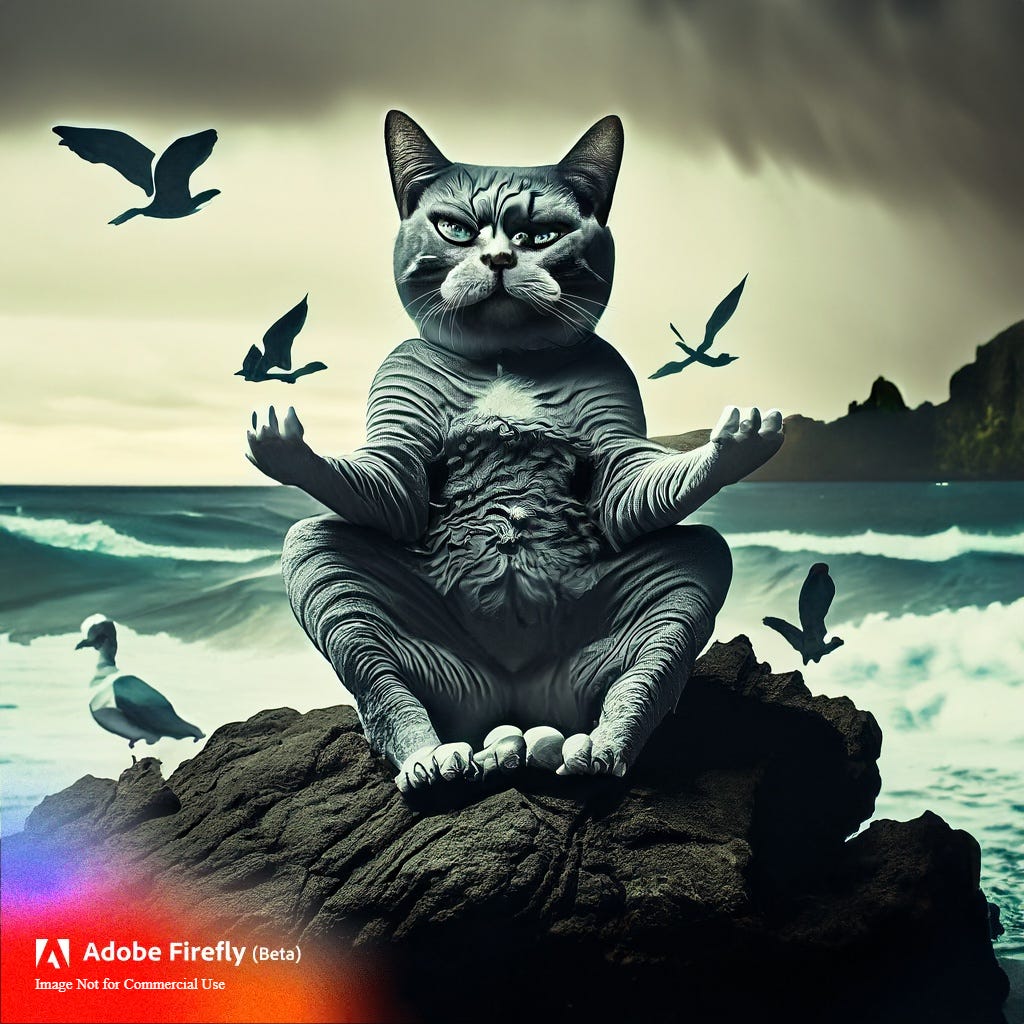Does artificial intelligence have a place in the creative landscape?
Let's talk about the pink AI elephant in the room
I’ve put off writing this one for a while because when it comes to artificial intelligence and what our futures could look like, I don’t have The Answers!! But I do have The Thoughts. I wrote a pretty comprehensive piece for Dieline a few months back on AI in design and branding, and yeah, your girl has been dabbling in AI for kicks. (see images below)
So! Let’s get into it.

The Ethics of AI
Artificial intelligence is a really sexy topic right now, but I can’t discuss AI without mentioning the very unsexy ethical issues Artificial Intelligence poses. Artificial intelligence is biased, and it’s common practice for AI models to be trained on work pulled from the internet from creators who did not consent to this, nor are receiving any kind of compensation in return. This is not only bad practice, but creates complicated copyright and ownership issues.
Getty Images and some individual artists have sued generators like Stability AI, Midjourney, and DeviantArt for copyright infringement because they used “billions of images downloaded from the internet without artists’ consent,” but we have yet to see the outcome of these cases. And fyi, rules are different around the world, from Korea, Japan, China, Australia, Singapore, and to Thailand.
“I see people on both sides of this extremely confident in their positions, but the reality is nobody knows,” technologist Andy Baio told The Verge. “And anyone who says they know confidently how this will play out in court is wrong.”
There’s the question of who owns the output, too. The US Copyright Office went back on their decision to extend a patent to Kristina Kashtanova’s comic book created with Midjourney. Just how much was Kristina was involved in the process, and how much would she need to be involved for them to issue the patent (and how is that measured)? Brett Schickler, author of a children’s book about a financial-minded squirrel, admitted that ChatGPT made the idea of writing a book seem possible—so if he couldn’t have done it without artificial intelligence, did he really do anything at all? Should an AI-generated Rembrandt painting be credited to Rembrandt himself, even if it’s produced centuries after his death?
Again, let me remind you: I don’t have the answers here. No one does, and the technology is moving at a faster pace than any courts do—and just because a court of law deems something legal doesn’t make it ethical. But these ethical questions and qualms should stay front of mind certainly not be dismissed simply because AI is a really cool tool that can help me produce cat illustrations.

Is AI Art Real Art?
In a recent piece on The Harvard Gazette, they posed the question: if art isn’t created by a human, is it still art? The writer, Liz Mineo, spoke with five very different artists to see if “they see AI as a threat or a collaborator or a tool to further their own creativity and imagination.”
I loved reading everyone’s responses, and this single sentence from mixed media artist Matt Saunders really stuck out to me:
“Art means what we ascribe to it.”
If this is the case, then really the question becomes: what makes art meaningful?
Psychology Today tried to answer this question by interviewing visitors to the Whitney Museum of American Art. They found that visitor responses could be grouped into a few broad themes that made them meaningful. Some of these had to deal with insights about techniques and materials or the artist’s process, but other themes included a deeper awareness of self and a better understanding of the world.
This study, of course, only involved visual art, and I’d argue that other types of art (like music, dance, or creative writing) would broaden those themes a bit. I personally think that art is meaningful when it offers a transportive quality—not necessarily in the physical sense, but emotionally or mentally, like when we encounter something that allows us to be a kid again. I also believe that art can be for entertainment purposes, and maybe it doesn’t have to have a deeper meaning to be meaningful.
With this, we can probably say that AI-generated art is meaningful, because, well, anything can mean something to someone (despite the fact that AI art’s very existence may still be questionable and ethically murky). And although artificial intelligence may provide us with some pretty impressive cat images things, I tend to be of the mindset that there is a certain je ne sais quoi about being human that AI just can’t capture.
Yosvany Terry, a saxophonist, percussionist, and composer who was interviewed for that Harvard Business piece, put it well.
“When you hear those compositions by AI, they lack surprise, emotion, and even silence. I love dramatism in music, and for me, emotion in music is important, and AI is not there yet.”
Could artificial intelligence get there one day, though? I told you! I don’t know!!

Using Artificial Intelligence in the Creative Process
When the Colorado State Fair gave an award to an AI-generated image, people weren’t exactly happy about it—a verbatim response was, “We’re watching the death of artistry unfold right before our eyes.” That’s exactly how I used to feel about AI.
What used to scare me most about the rise of artificial intelligence was the decreased need to be creative. A professor of mine in college said to the class, “Think of ten impossible things a day, because the imagination is a muscle,” and I have never forgotten that. So if I’m letting a computer do all the hard, imaginative work, then that could threaten my capacity to dream and create, right?
When I asked this question of Gerardo Rivera, Head of Brand Experience at Design Studio Nuovo and an Art Center College of Design professor who is a big proponent for introducing his students to AI, he gave me a reassuring response.
“One of the things that’s really interesting as an artist is that you’re not always typing or voicing your ideas,” he said. “You're just kind of going, you're doing things, and you're letting the flow take you. Now you're engaging another part of your brain. With this, you’re still taking those ideas, but you’re putting them into text. It forces you to be really good at exercising that creative muscle on the visualization, and they can visually articulate the future that the mind starts to dream up. So if you’re lazy, yeah, go for it. Put in a lazy prompt, and you’ll get an average idea. But for those pushed by the tool and their creative nature to become better at what they do, the sky’s the limit.”
In the research, interviews, reading, and writing I’ve done about AI, the opinion that has resonated with me the most is that artificial intelligence is a tool people can use in the creative process. Will certain companies fire their copywriters and designers and artists and turn to AI for a much cheaper solution? Of course (and some already have). But not everyone will because while outputs can certainly be impactful, a human touch—and an understanding of the art—is still vital in taking that output and making it appropriate for the situation/surprising and delightful/fine-tuned/etc.
Basically, it can be a great place to get inspiration in the early phases, or maybe even to do sanity checks on work, but we’re not at the point yet where we can just download whatever AI produces and call it a day.
I really loved seeing what photographer Cindy Sherman has been doing with AI. “I was playing around with one of these face-tuning apps, the ones that are designed to make you look better…you load in selfies, and it creates multiple versions of you. Only I was making myself look weird, or just different. So I put those selfies into one of the AI programs—it creates various ‘types’ of you; anime, cosmic, apocalyptic, etc. So it was a sort of double manipulation.” She’s not just putting in photos of herself, but she’s purposefully making the input bizarre, in turn making the results all the more bizarre. It’s such a fun and clever way to approach AI, and I love that she’s essentially toying with the system.
As for myself, aside from weird cat illustrations, I’ve used AI (specifically Chat GPT) for brainstorming purposes. Once I’ve put together some talking points in a lengthier article, I might turn to Chat GPT and see if I’m missing major points that could flesh out the piece further. I don’t go beyond that, though.
Having worked as a freelance writer for a decade now, putting an assignment together is second nature (read: quick ‘n’ easy). I get a certain pride out of shaping a piece, out of taking interviews and sources off the web to cite and crafting them into 1,000 words of something thoughtful. Furthermore, the people who share their stories with me give me a lot of trust, and I could not outsource that to a computer and feel good about it.
More recently, I’ve enjoyed using AI to brainstorm ideas for the more mundane tasks of my creative life—namely, social media. I have always been kind of shit at social media, despite really enjoying it and having a video go viral on TikTok once (it was—you guessed it—a cat video). And many creatives I know are great at making their art but then they clam up the moment they have to talk about their art. So Chat GPT has been a way for me to get ideas for types of social media posts I can create. It’s definitely helpful in managing the less creative sides of a creative life and business, and for taking some of that pressure off.
I’m not having Chat GPT write my next assignment or my next book, though, because, honestly, I enjoy those experiences. People obviously fear AI because they worry it might take work away from them, or they have concerns about how powerful and knowledgeable it could become. But, speaking from a creative’s perspective, what is scary about it is that it makes creation effortless. Effortless enough that people want to forgo the process and get to the end product.
And I get it, because we live in a society that rewards productivity and reaching that end product, not in one that relishes the time and precision and skill required for that journey.
But if you could skip that part, would you?
Some folks will, especially when we take into account the pressures of a capitalist world. And I know I’m being optimistic here, but I like to think that once all the hype around AI settles, then people will start to see it as part of that journey vs. the destination itself.
Rudy Sanchez, one of my fellow contributors at Dieline, explained that automation transforms a job, not necessarily eliminating that job. “ATMs have offloaded basic transactions from human tellers to machines, freeing up tellers to focus on more complex services not possible on a touchscreen,” he wrote. “Robots have also taken over some dangerous warehouse or factory jobs, reducing employee risk. Similarly, computers radically changed how graphic designers created but didn’t send them packing."
Perhaps what we’re witnessing is a transformation of the creative process. Who knows? I don’t.
But I know that I like making. The journey can be messy and frustrating and time-consuming, sure, but it’s my life and how I like to spend my time. I’m not saying that my relationship to AI will never change, but art and creativity has never been about just the final stage for me. Even if there was never a practical need again for me to write or take photographs or sew, I think I’d still want to do it, every day. ✿
I love writing this newsletter. If you enjoy it, too, or have found it useful, you can support me (and the creation of it) in the following ways:
Forward it to someone you think might appreciate it 👯
Like and comment because I always enjoy hearing your thoughts 🤗 Have you been using AI? Do you think AI art is art? Where do you draw the line with AI usage in creative fields?
Buy me a book 💁♀️
Thanks as always for being here!
- Theresa


AI is the stuff of my nightmares. And for every automation we take on, people lose jobs. I internalize my self-loathing when I use the self-checkout at Whole Foods, but my WF foods can be ridiculous with lines at the times I run in for only a couple of things. It's still wrong (that area could be at least two more registers and one more job (there's always the helpful attendant at the ready). While the middle class is dying, we are also starving out the working class. All for automation. I just wonder how it all ends. Fabulous think-piece, Theresa. xo